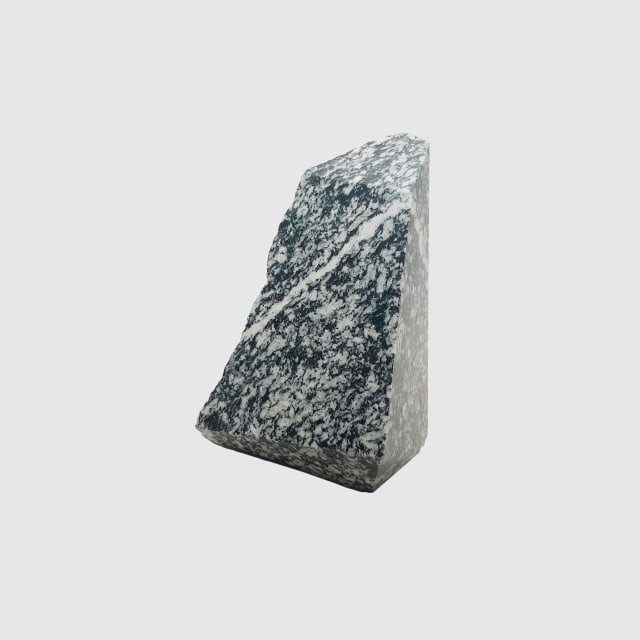Our surrounding environment is repeatedly mined for its utilitarian materials, and we often overlook the beauty and integrity of our natural materials and resources. For example, while the plentiful New Zealand sedimentary basement rock Greywacke is used to tar-seal our roads, its essence can be lost in this industrial process, and so too, our connection with its original form and beauty.
Enter the artist, in this case Taranaki sculptor, Chauncey Flay. Chauncey celebrates the natural object by excavating it from its own environment. He repurposes it, works with it, makes it shine (literally) and in so doing, celebrates the many materials he uses (rocks, coral, stones), dug deep from beneath the earth or ocean. He picks up a fractured and veined rock, studies it for a considerable time, and finally, wielding a hammer, splits it. Then using a flat lap with a diamond pad, Chauncey begins to polish different aspects of the rock until it is smooth and faceted. Often adding other pieces of rock to the sculpture, Flay may reconnect these pieces by using neodymium magnets, polyfiller or even simple concrete. The finished artworks are sublime in their juxtaposition between light and dark, rough and smooth, emptiness and solidity, and speak to a world of space and time.
Flay, in deconstructing and reconstructing this natural material, allows us to contemplate it in a fresh and often meditative way. We see the rough surface against the smoothness of the artist’s touch and in some way this allows the viewer to reconnect again with our environment. Says Flay, “In all my works there is a physical process of breaking and putting back together. The language of geometry references architecture as a healing and rebuilding process. The faceting of stone is a slow and meditative reductive process that expresses the relationship between matter and time.”
Greywacke is not the only material Flay works with. He has also used bricks, marble, coral and obsidian. Before returning to New Zealand in 2017, Flay lived in the Cook Islands for six years with his family. Here, dead and bleached coral found above the high tide mark on the coastline or dug out of the ground from local building sites, were used by him in his ‘Coralscape’ series. Working alongside and influenced by Rarotongan artist Mike Tavioni, Flay's work draws on Cook Island traditions, as well as referencing the changing environment of the South Pacific and the fragility of the natural world. Flay cuts through a block of coral and then fills the remaining honeycombed space with concrete, limestone powder and water. This process allows Flay to reimagine the structure of the coral before it was affected by climate change.
Similarly, Chauncey Flay’s sculptures ‘Morven II' and 'Morven III' discuss the concepts of shelter and home. The bricks Flay used in these works are from the Morven Homestead, Darfield, destroyed in the Christchurch 2010 earthquake. His reconstruction of the bricks allows the viewer to contemplate the fragility of a home or shelter, in the face of such environmental upheaval. Says Flay,“I've come across an object in nature at a certain time and I've created an art work out of it but it doesn’t stop the object going through its normal track over time”
Chauncey is influenced by architectural ‘Brutalism’ and often uses the concept of bunkers or shelters in his exploration of form. He is good friends with New Zealand stone artist, Joe Sheehan, and is influenced by a wide range of artists including Rachel Whiteread, Christian Boltanski and Ana Mendieta.
Flay grew up in New Plymouth and studied art at the Auckland University of Technology. He has lived in Germany and Poland and also spent six years living in the Cook Islands with his family. Flay now resides in Ōpunake, Taranaki.
